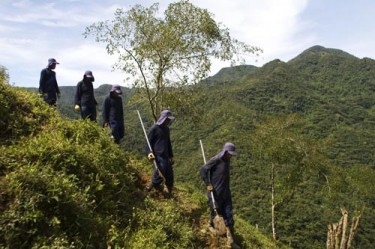
The coca plant is native to the Andes. Its bush has been cultivated and traditionally consumed by local people for centuries. Many products and the leaves themselves can be legally purchased in Peru and Bolivia.
However, coca leaves are also the raw material for the production of cocaine. As a result, Peru, Colombia and Bolivia are the three largest illegal cocaine producing countries in the world.
According to the UNODC World Drug Report 2012 there was an overall decline in global production of cocaine between 2006 and 2010. This was in part due to the reduction of coca bush cultivation in Colombia. In spite of this, the report also underlines that in the same period coca bush cultivation and cocaine production actually increased in Bolivia and Peru.
Drug production and trafficking is a major issue in Latin America that governments are constantly trying to deal with. And at last April’s Summit of the Americas many were of the opinion that the US-led war on drugs has failed.
Plan Colombia
Ricardo Vargas, a TNI researcher [es] and a leading expert in drug trafficking in Colombia, states that the Plan Colombia, the anti-drug strategy funded by the US, spent more than $8 billion in strengthening the army and conducting military actions against insurgent groups linked to drug trafficking.
Vargas argued in an interview that beyond violence:
“The big issue is that supply and trafficking are major topics absent in these debates. Colombia is mainly a producing, processing and trafficking country, which means that the country still has not begun to analyse in-depth the most important dimension of its competence. With the added dimension that supply and trafficking ends up being replaced by security concerns.”
Bolivia’s new ecological battalion
Bolivia’s president, Evo Morales, recently declared that drug trafficking presents a major challenge to his country and also announced a new Ecological battalion that aims to prevent illegal coca cultivation in National Parks.
However, journalist and blogger based in La Paz Andres Gomez claims a deep contradiction [es] in the president’s discourse:
“[The] UN warned that 93 percent of the coca leaf from the Chapare region goes to the illegal market (not to say drugs), and reported that the country has more than 30 thousand hectares.
Recently, a Latin American Research (CELIN) investigation certified that the country only requires about 8 thousand hectares for traditional consumption (“chewing” and medicinal use) of the coca leaf. According to Law 1008…the country should have only 12 thousand hectares, but there are over 30 thousand.
President Morales acknowledges that drug trafficking is a problem for the government of Bolivia, but the president of the coca grower’s federation – which is the same person – defends the production of… unionized [coca], whose main market is the illegal one.”
Peru, a traffic corridor
Since the year 2010 Peru, is the largest pure cocaine producer in the world. One of the major challenges for Peruvian authorities are the increasing number of cocaine trafficking roads.
According to analyst Alfredo Palacios Dongo, former Commander in Chief of the Peruvian Army and owner of the blog Planteamientos Peru [es]:
“[International transit routes for cocaine] from Peru, in addition to the corridor between Central America and Mexico to the US, [are] increasing…shipments to Brazil, Argentina, Chile and Bolivia.[…] Brazil, a country with high demand of drugs – second largest consumer with 11 million of consumers, only after the US with 22.6 million, and that also has the “crack” epidemic.”
Andean community and joint initiatives
The Andean Community is currently implementing the Anti-illicit Drugs Program (PRADICAN), a European-funded project that seeks to standardize statistical information about production, trafficking and consumption of drugs in the Andes, as well as coordinating the responses of member-states.
The Andean Community states [es] that an integral approach is needed, targeting primarily the following measures:
- blocking shipment routes used by drug dealers
- reducing access to supplies and chemical precursors
- addressing drug issues as public health issues and not only as a security concern
- joint action to cut off illegal funding streams and intelligence and early warning systems against drug trafficking networks.
For further information on the topic, please view the following publications from our partners:
Latin America and the Caribbean: Illicit Drug Trafficking and US Counterdrug Programs, from the Congressional Research Service (CRS), Washington DC, United States.
Mexico’s Drug Trafficking Organizations: Source and Scope of the Rising Violence, from the Congressional Research Service (CRS), Washington DC, United States.
Guatemala: Drug Trafficking and Violence, from the International Crisis Group, Brussels, Belgium.
For more information on issues and events that shape our world please visit the ISN’s Security Watch and Editorial Plan Dossiers.

